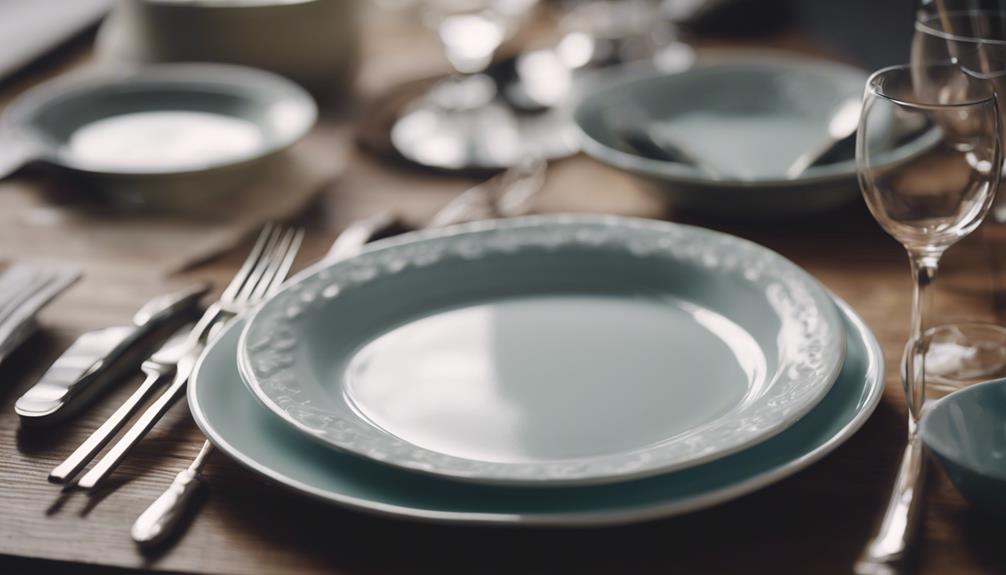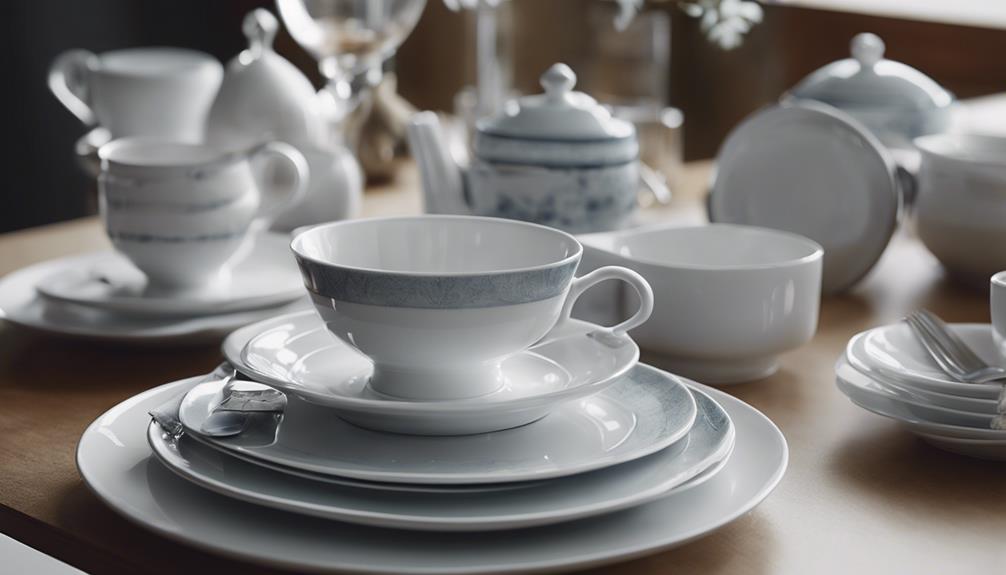Yes, VAT is applied to tableware items like plates, glasses, and silverware. Specific rates may vary. Being mindful of these rates guarantees accurate pricing, aiding in budgeting and effective purchasing. Know the VAT rates before buying to avoid surprises. Understanding VAT regulations globally helps with informed decisions and compliance, impacting pricing and behavior. Exemptions exist for certain tableware items based on criteria. Adherence to VAT is essential for businesses, affecting costs and profits. Establish checkpoints for proper VAT compliance. Consider consulting for clarifications due to VAT complexity. Being well-informed about tableware VAT is vital for making informed decisions.
Key Takeaways
- VAT is applied to tableware items like plates, glasses, and silverware.
- Specific VAT rates may vary based on the nature of the tableware.
- Understanding VAT regulations aids in accurate pricing and budgeting.
- Some tableware items qualify for VAT exemptions based on specific criteria.
- Compliance with VAT regulations is crucial for businesses to avoid penalties.
Understanding Tableware VAT Rates

If you're looking to grasp the VAT rates applicable to tableware items, understanding the standard rates is important. VAT is applied to various tableware items such as plates, glasses, and silverware. These items are generally subject to standard VAT rates, but specific VAT rates may vary based on the nature of the tableware. It's vital to be aware of the specific VAT rates for different types of tableware to guarantee accurate pricing for household or business purchases. By understanding the specific VAT rates applicable to tableware, you can avoid any pricing discrepancies and maintain compliance with tax regulations.
Different tableware items may attract different VAT rates, so it's important to familiarize yourself with these specific rates to make informed decisions when purchasing tableware items. Being knowledgeable about the VAT rates for tableware can help you budget effectively and plan your purchases accordingly. Remember to check the specific VAT rates for the tableware items you intend to buy to avoid any surprises at the checkout.
Tableware VAT Regulations Worldwide

Tableware VAT regulations vary worldwide, impacting how much tax you pay on items like cutlery and dishes.
It's essential to be cognizant of the different VAT rates in various countries to make informed purchasing decisions.
Understanding these regulations can help you save money and guarantee compliance with tax laws.
Global Tableware Tax Laws
Understanding the diverse VAT regulations on tableware across the globe is essential for navigating the tax landscape in the industry. Different countries have specific tax laws governing the VAT rates applied to tableware. Some regions may exempt certain types of tableware from VAT, while others adhere to standard rates.
Being aware of the global tableware tax laws is important for businesses operating in this sector. These VAT rates can have a significant impact on pricing strategies and consumer behavior. It's important for retailers and manufacturers to comply with these regulations to avoid potential penalties.
Stay informed about the tableware VAT laws in different countries to navigate the tax implications effectively and ensure compliance with local tax laws.
Vat Rates Comparison
Comparing VAT rates on tableware worldwide reveals significant variations in tax regulations across different countries. Some regions apply standard VAT rates to tableware purchases, while others offer exemptions. Understanding these differences is important for businesses in the industry to comply with specific VAT regulations.
Certain countries may have reduced VAT rates for tableware, aiming to promote affordability or support specific sectors. It's vital to adhere to VAT laws concerning tableware to prevent penalties and ensure accurate financial management.
Exempt Tableware Items From VAT

When considering VAT regulations, you must take into account which tableware items qualify for exemption based on specific criteria and regulations. While tableware items like cutlery are usually subject to VAT, there are exceptions for certain pieces such as antique or collectible items. The eligibility for VAT exemptions on tableware items is determined by specific criteria set forth in the regulations. Everyday tableware items such as plates, glasses, and mugs are typically not exempt and are subject to VAT. Understanding these VAT regulations for tableware can assist in effectively managing costs related to such items.
| Tableware Item | VAT Exempt | Specific Criteria | Regulations |
|---|---|---|---|
| Cutlery | No | Antique or collectible pieces | Subject to VAT |
| Plates | No | Everyday use | Typically subject to VAT |
| Glasses | No | Everyday use | Typically subject to VAT |
| Mugs | No | Everyday use | Typically subject to VAT |
Implications of Tableware VAT on Businesses

When considering the implications of VAT on tableware for your business, it's essential to factor in how it impacts your costs and pricing strategies.
Ensuring compliance with VAT regulations on tableware sales is vital to avoid penalties and maintain financial accuracy.
Understanding VAT rates on tableware allows for precise pricing and proper tax collection procedures.
VAT Impact on Costs
Understanding how VAT on tableware impacts your business costs is vital for effective financial management in the hospitality industry. VAT on tableware, charged at the standard rate, directly influences your expenses, affecting pricing strategies and profit margins. By factoring in VAT on tableware, you guarantee accurate budgeting and pricing structures. Proper management of these costs can contribute to financial stability and align your business with compliance regulations. Below is a table illustrating the potential impact of VAT on tableware costs:
| VAT on Tableware | Standard Rate |
|---|---|
| Increased Costs | 20% |
| Pricing Adjustments | Essential for Profitability |
| Financial Planning | Critical for Budgeting |
Compliance Requirements
In order to comply with VAT regulations, businesses selling tableware must maintain proper record-keeping of their sales. Tableware, including cutlery, is subject to VAT at the standard rate.
It's essential for retailers of tableware to grasp VAT laws to guarantee compliance with tax requirements. Proper record-keeping of tableware sales is vital for businesses to meet VAT regulations. Failure to adhere to VAT regulations on tableware can lead to penalties.
Checkpoints for Tableware VAT Compliance

To guarantee compliance with VAT regulations on tableware, businesses must establish clear checkpoints for proper record-keeping and accurate VAT calculations. When dealing with tableware subject to VAT at the standard rate, it's important to maintain detailed records of all transactions involving these items. This includes invoices, receipts, and other relevant documents to ensure transparency and accuracy in VAT reporting.
Regularly reviewing and updating your accounting systems to reflect the correct VAT amount on tableware sales is vital for compliance. Implementing internal controls to double-check VAT calculations can help prevent errors and discrepancies that may lead to non-compliance issues. Training your staff on VAT regulations related to tableware can also contribute to smoother operations and accurate tax filings.
Managing Tableware VAT Costs

Make sure you have a solid grasp of how VAT impacts your tableware costs to effectively manage your VAT expenses.
Tableware items like cutlery, glassware, plates, and serving utensils are subject to VAT at the standard rate. Understanding the implications of VAT on your tableware purchases is important as it directly influences your pricing decisions.
When selling tableware, businesses must adhere to VAT regulations to guarantee accurate tax collection. Proper record-keeping of VAT on tableware expenses is essential for maintaining financial transparency and compliance with tax laws.
By managing your tableware VAT costs efficiently, you can control your overall tax liabilities and improve your financial management. Stay informed about the VAT rates applicable to different tableware items to make informed decisions and avoid any potential issues with tax authorities.
Keeping detailed records and staying updated on VAT regulations will help you navigate the complexities of tableware VAT costs effectively.
Consultation for Tableware VAT Clarifications

Considering the complexity of VAT regulations, seeking consultation for clarifications on tableware VAT is highly recommended. Tableware such as cutlery, plates, and glasses are generally subject to standard VAT rates. However, it's crucial to note that different types of tableware may have varying VAT rates.
When making purchases that include tableware, understanding VAT regulations can help you make informed decisions and avoid unexpected costs. By consulting with tax professionals or utilizing resources provided by tax authorities, you can gain clarity on the applicable VAT rates for the specific tableware items you intend to buy. This proactive approach not only guarantees compliance with tax laws but also helps you budget more effectively for household items.
With a better understanding of how VAT applies to tableware, you can make purchasing decisions that align with your financial goals and priorities.
Frequently Asked Questions
What Food Do You Pay VAT On?
When it comes to food, you typically pay VAT on ready-to-eat meals, snacks, beverages, and certain ingredients or packaged items.
VAT isn't usually applied to basic food items like fruits, vegetables, meat, or dairy products.
Understanding what food items are subject to VAT is crucial for accurately calculating costs and staying compliant with tax regulations.
Keep track of which food products fall under the VAT umbrella to manage your expenses effectively.
What Do You Not Pay VAT On?
You don't pay VAT on certain essential items like food, children's clothing, books, and some healthcare services. This exemption aims to reduce the financial burden on necessary goods and services.
Understanding these VAT exemptions can help you budget more effectively and prioritize your household spending on essential items. By knowing what items are VAT exempt, you can make informed choices to manage your expenses better and make sure you aren't paying unnecessary taxes.
What Items Are Subject to Vat?
Household items like cutlery, delf, linen, towels, and sheets are subject to VAT at the standard rate. Various household goods fall under this category, including cutlery and linen.
Items such as towels and sheets aren't exempt from VAT. It's important to be aware of these VAT charges when purchasing these household essentials as they contribute to the overall cost.
Does Food Have VAT Tax?
Food generally doesn't have VAT tax as it's considered a necessity. However, some exceptions apply to luxury food items or food consumed in restaurants, which may be subject to VAT.
Understanding these nuances can help you budget and make informed purchasing decisions. Remember to check for specific VAT rates or exemptions based on the type of food you're buying to avoid any surprises at the checkout.
Conclusion
To sum up, mastering the world of tableware VAT can be intricate, but with proper understanding and compliance, businesses can avoid unnecessary costs and penalties.
Just like a skilled chef carefully selects the perfect ingredients for a recipe, ensuring tableware VAT compliance requires attention to detail and precision.
By staying informed and seeking guidance when needed, businesses can confidently serve up success without any unexpected surprises on the menu.








